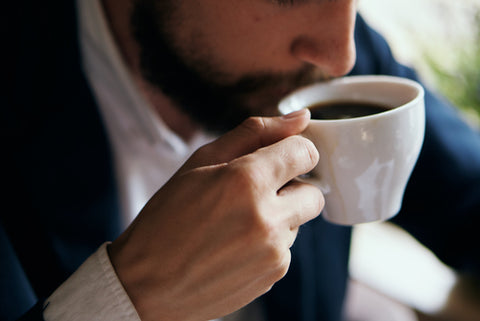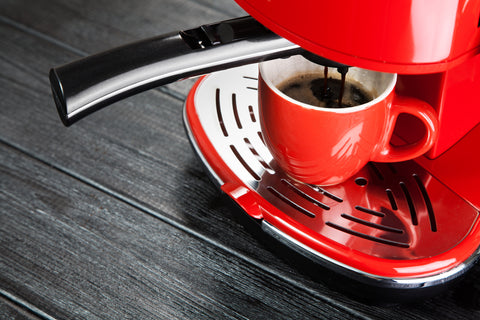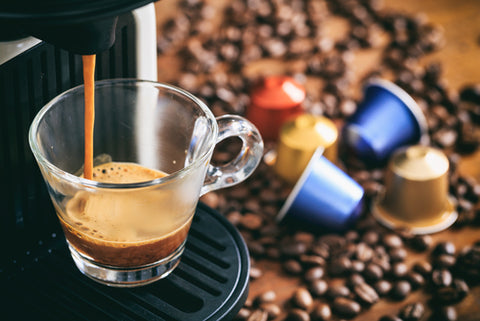One of the best things about owning your own espresso machine is the ability to pull a double shot whenever you want. After all, if you can’t whip up your own cappuccino or latte on a moment’s notice, what use is there in owning such a spectacular piece of machinery?
However, there’s also nothing more distressing than pulling your shot and having it end up tasting off. Never fear! We here at ThinkCrucial are here to help you diagnose what’s wrong with your espresso and give you some pointers on how to fix it.
Troubleshooting Basics
When you are looking for answers as to why your coffee isn’t turning out like you want, the first thing you should look at is the puck. The puck is what the compressed grounds in the basket looks like after you’ve done a pull. They call it a puck because it resembles a hockey puck.
If you notice that the puck is extremely hard, then you’ve overfilled your filter basket. Over-filled baskets also lead to under extraction and bitter shots. That’s because the water can’t find channels through the coffee, so it goes around or finds a crack and funnels through.
On the other end of the spectrum is the sloppy puck. This is what happens when the puck ends up as mush instead of a nice firm mass. The lack of coffee is going to result in over extraction and sour coffee as the water hangs out and muddles in your grounds instead of being pressed through.
The best way to ensure that you’ve got the proper amount of coffee is of course to weigh it. Read your machine’s manual to be sure, but most machines take 22 grams. If you have a smaller basket, you’ll need to adjust accordingly.
Remember that whatever mass of coffee your machine takes, the ideal pull will be twice that. So a 20 gram puck will yield a 40 gram shot.
When Your Espresso is a Little too Sour
A little sourness is expected in some light roasts. That brightness is the acidity that some espresso drinkers crave. But if you’re getting excessive sourness from your machine, there might be a problem, especially if you’re using medium to dark roasts.
In some cases, the sourness can be solved by letting your coffee age a little longer. New beans are still outgassing CO2 and this can wreak havoc with your shot and with the crema.
Another situation that causes sourness in your coffee is the water being a little colder than it should be. This leads to under extraction, which is the main cause of sourness.
Remember that your source water should be just shy of boiling. You want it at roughly 94 to 96 degrees Celsius (201 to 205 degrees Fahrenheit). If your water is properly heated, then try grinding your beans a little finer to give your shots a longer extraction.
Solving the Bitterness Problem
Coffee also has its bitter notes, but when they start to overwhelm the other flavors in your brew, there’s a situation. The primary cause of over extraction is the grind of your beans. Try a couple of pulls with the grind a little coarser than you’ve been doing it.
Another cause of over extraction and excessively bitter espresso is when your brewing water is too hot. Again, you’re aiming for your water to be between 94 and 96 degrees Celsius. Any hotter and you’re pulling too much from your beans and the resulting brew will suffer.
The least common cause of bitterness in your espresso is a dirty machine. Check the filters and the heads to make sure they are clean. You shouldn’t have any residue anywhere in the machine. If you do, wipe it down, flush it, and try another pull.

Other Flavor Issues
There can be other issues with your espresso than just bitterness and sourness. Sometimes you get a flavor profile that’s reminiscent of diner coffee that’s been sitting on the warmer all night. In that case, you should check your filters and backflush your machine. Here are some other odd tastes and their probable causes and solutions.
- Tastes like Instant – In this case, you’re over extracting your grind. The best way to prevent over extraction is to grind your beans a touch coarser. Then stop your pull a little earlier. You should get the same volume of espresso, but you’ll notice a marked improvement in the flavor and mouthfeel.
- Ashiness – Sometimes a dark roast goes wrong and you’re left with a brew that tastes a little ashy. Unfortunately, there’s not much you can do other than change your beans. If you want to mask the flavor, you can by dialing up the crema and dark stopping your espresso shot. This will give you a little more brightness.
- Metallic after-tones – If you’re getting this in your espresso, you may not have rinsed your machine enough after your last cleaning. This taste profile also comes out when your machine is fresh out of the box. If your espresso maker has a built in grinder, check the burrs to ensure that they aren’t excessively worn. Lastly, make sure that you aren’t using distilled water. The lack of mineral content in source water can result in some pretty funky coffee. Check your water filters to ensure they’re still working well.
If you notice that your coffee is extremely weak and watery, you should check when it was roasted. If it’s been under a week, then your coffee needs to rest. When a bean is roasted, it produces carbon dioxide and extremely fresh coffee will give your crema more bubbles than you want. It also makes the crema dissipate more quickly. Ideally, your beans should be between 7 and 21 days after roasting for best results.
Other crema issues you may see include a thin crema that’s extremely dark with very tiny bubbles. This is another example of over extraction and is usually caused by extremely hot water. You should check the water temperature to ensure it’s in the optimum range.





